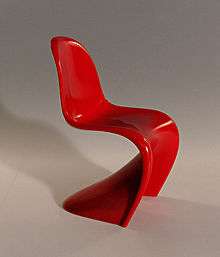Verner Panton
Verner Panton (13 February 1926 – 5 September 1998) is considered one of Denmark's most influential 20th-century furniture and interior designers. During his career, he created innovative and futuristic designs in a variety of materials, especially plastics, and in vibrant and exotic colors. His style was very "1960s" but regained popularity at the end of the 20th century. As of 2004, Panton's best-known furniture models are still in production (at Vitra, among others).
Verner Panton | |
|---|---|
_by_Erling_Mandelmann.jpg) Panton photographed by Erling Mandelmann | |
| Born | 13 February 1926 Gamtofte, Denmark |
| Died | 5 September 1998 (aged 72) Copenhagen, Denmark |
| Nationality | Danish |
| Occupation | Architect |
Biography
Panton was already an experienced artist in Odense when he went to study architecture at the Royal Danish Academy of Art (Det Kongelige Danske Kunstakademi) in Copenhagen, graduating in 1951. During the first two years of his career, 1950–1952, he worked at the architectural practice of Arne Jacobsen, another Danish architect and furniture designe. Panton turned out to be an "enfant terrible" and he started his own design and architectural office. He became well known for his innovative architectural proposals, including a collapsible house (1955), the Cardboard House and the Plastic House (1960). Near the end of the 1950s, his chair designs became much more unconventional, with no legs or discernible back. In 1960 Panton was the designer of the very first single-form injection-moulded plastic chair. The Stacking chair or S chair was mass produced and became the most famous of his designs derived from organic shapes echoing curves of the human body – in this case the tongue.[1]

In the late 1960s and early 1970s, Verner Panton experimented with designing entire environments: radical and psychedelic interiors that were an ensemble of his curved furniture, wall upholstering, textiles and lighting. He is perhaps best known for a series of interior designs for Bayer's yearly product exhibition, held aboard excursion boats,[2] one is now preserved in a museum. He is also known for a hotel in Europe that utilized circular patterns and cylindrical furniture.
Additionally, Panton is well known for his innovative design work for Der Spiegel, a well-known German publication in Hamburg.
Works
- Cone Chair (1958)
- The Panton Chair (1967)
- Peacock Chair
- Verner Panton S-chair model 275 Thonet
- Bayer exposition ships Visiona O + II, Köln, 1968, 1970 → "VISIONA II" Video (Laufzeit 2:08 Min) on YouTube
- Spiegel Canteen, Hamburg, 1969
See also
References
- Hoffman, Anna. "Sex and the Sixties: Verner Panton's Pop Fantasia". Apartment Therapy. Retrieved 28 July 2020.
- "Vitra Design Museum". Retrieved 26 February 2016.
External links
- The Official Verner Panton Reference Portal and Archives: Photos, designs and producers
- MY PANTON HOME - The worlds largest Verner Panton collection
- Verner Panton biography at Danish Furniture
- PANTONWORLD - A collectors tribute to Verner Panton
- Verner Panton at the design agency TAGWERC with texts on his designs and his design philosophy (in English)